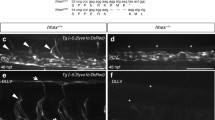Abstract
The lymphatic endothelium has mostly been thought to be derived by sprouting from specialized veins. Recently it has been shown that mice deficient for the homeobox transcription factor Prox1 are practically devoid of lymphatics. We have studied the expression of Prox1 mRNA and protein in chick embryos and human fetuses. In the chick, Prox1 is expressed in specific compartments of all germ layers. In the ectoderm, it is found in the neural tube, trigeminal, spinal and sympathetic ganglia and the retina, and also in placodal structures such as the lens, olfactory, otic, facial, glossopharyngeal and vagal placodes, and the apical ectodermal ridge. In the endoderm, Prox1 is a marker of hepatocytes, bile duct and pancreatic epithelium. In the mesoderm, weak expression is observed in cardiomyocytes, and strong expression in lymphatic endothelium. Identical expression domains are found in 19-week-old human fetuses. In day 6.5 chick embryos, there are several sites of contact of lymphatics with the jugular vein, which has a mixed endothelium of Prox1-positive and -negative cells. The only non-lymphatic endothelial cells expressing Prox1 are found on the concave side of the cardiac valves. To further analyse development of lymphatics, we studied early chick embryos and observed scattered Prox1-positive cells in the dermatome, giving rise to Prox1-positive lymphatic networks during subsequent development. Furthermore, the anlagen of the posterior lymph sacs and the paired thoracic duct can already be observed in day-4 chick embryos. Our studies show that lymphatics develop much earlier than previously described, and they mostly do not seem to be derived by sprouting from veins. In contrast, lymphangioblasts are present in the deep and superficial compartments of the early mesoderm, independently giving rise to the deep and superficial lymphatics.
Similar content being viewed by others
Author information
Authors and Affiliations
Additional information
Accepted: 9 August 2001
Rights and permissions
About this article
Cite this article
Rodriguez-Niedenführ, M., Papoutsi, M., Christ, B. et al. Prox1 is a marker of ectodermal placodes, endodermal compartments, lymphatic endothelium and lymphangioblasts. Anat Embryol 204, 399–406 (2001). https://doi.org/10.1007/s00429-001-0214-9
Issue Date:
DOI: https://doi.org/10.1007/s00429-001-0214-9




